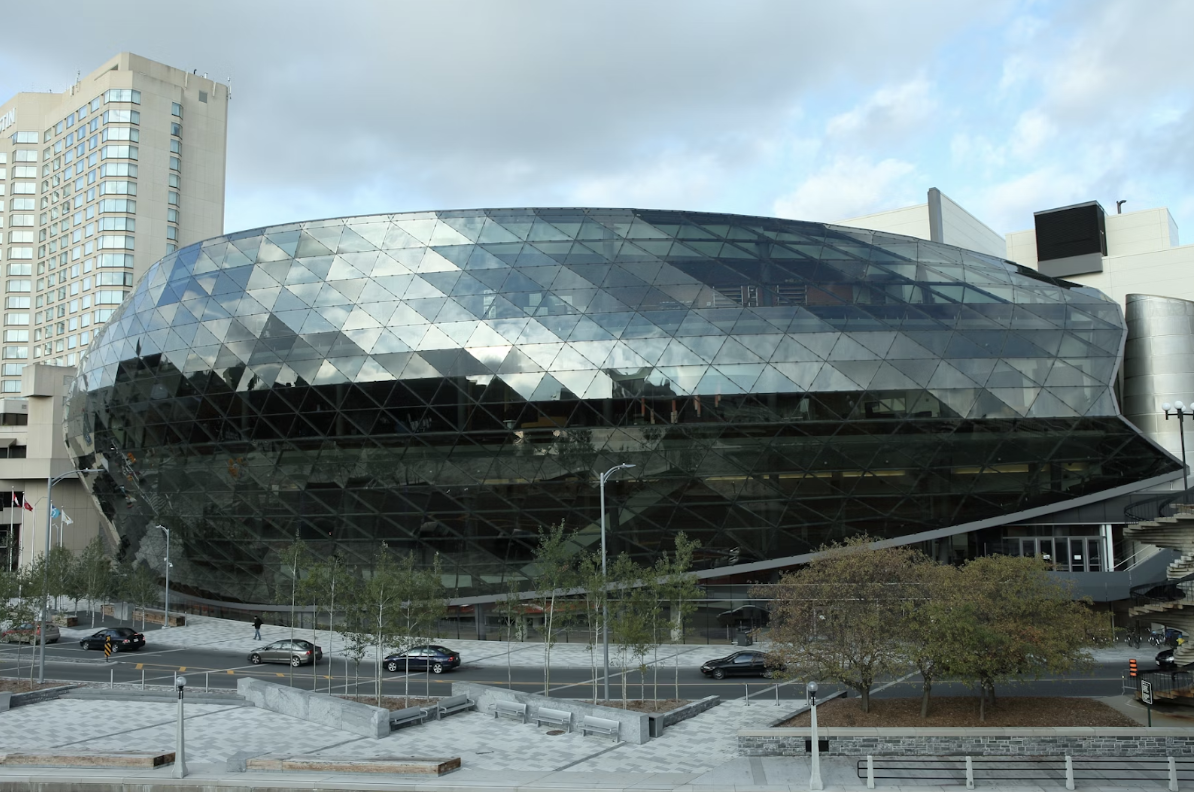Stories
Submit your story ideas, questions or concerns to [email protected] or join our news team!
CATEGORY
LANGUAGE

Vuk Cvetanovic Lalovic • Apr 25, 2024

(Antoine Giret, UNSPLASH).
The fourth session of the Intergovernmental Negotiating Committee (INC) will be held from Apr. 23 to 29 at Ottawa’s Shaw Centre. This Committee aims to develop an internationally legally binding treaty on plastic pollution, most notably in maritime environments,
The week-long summit is the penultimate session regarding a resolution that was proposed in 2022. It thus aims to advance negotiations to enable the treaty’s finalization in November 2024, according to the United Nations environment programme press release.
Estimates indicate that global plastic pollution could triple by 2040, from 9-14 million tons per year to 23-37 million tons annually. Research conducted by the UN environment program has shown that half of plastic residue originates from the packaging industry, followed by areas such as textiles, consumer products, or transportation.
In addition, a staggering 40 per cent of plastic packaging waste ends up in engineered landfills, with an additional 32 per cent lost to the environment. With such dire statistics, the assembled delegates have worked arduously to ensure the completion of the treaty by the end of 2024.

The Shaw Centre downtown Ottawa (Asif Ali/UNSPLASH).
This plan seeks to cut back on plastic and its derivatives in an equitable and pragmatic manner, a delicate balancing act that has required a spirit of cooperation and compromise among the delegates.
“We are seeing convergence on eliminating the uses that are problematic and avoidable. We will continue to need plastic for specific uses, such as renewable energy technologies. But there is growing agreement that short-lived and single use can go,” says Inger Andersen, executive director of the United Nations environment programme.
Indeed, a desire to ensure the proper use of the session’s week in Ottawa has galvanized many of the participants towards a text that is as close as possible to final. The session’s advance document prioritizes the optimization of the document’s finalization, and mandates any inter sessional work that may be necessary for the final draft’s completion.
Jyoti Mathur-Fillip, executive secretary of the INC, stated in a UN press release preceding the event, “Seize this opportunity, make these seven days count, deliver a text that is as close as possible to the final agreement that we all want to see.”
A spirit of multilateralism pervades the event, with the INC process being acclaimed as a critical new approach to contemporary challenges. Luis Vayas Valdivieso, chair of the INC, has stated that all member nations must “negotiate with accountability and integrity – grounded in the scientific evidence and facts on the scale and urgency of ending plastic pollution.”
Three thematic side events were held alongside the main session on Wednesday and Thursday, which were accessible through the session’s website. These included lectures on plastic pollution in marine environments, approaches to capacity build and financing mechanisms in a largely post-plastic world, and methods to enable a just and global transition away from mass plastic use.
These events featured over 180 participating delegates, including a variety of prominent experts in the field of marine life and environmental pollution.
In addition, a number of webinars will be available for observers wishing to participate in the ongoing discussions, which will be held on Apr. 27 and 28.
Prospects are optimistic regarding the final session, held in Busan, South Korea. However, even in triumph, a dire sense of urgency pervades the session. As told by Director Andersen, “Time is against us – both in terms of finalizing the instrument and how much more the planet can take.”
Events can be accessed through the UN environment programme’s events page.
United Nations resolution on plastic pollution reaches pivotal stage in Ottawa
Apr 25, 2024 • Vuk Cvetanovic Lalovic

Lauren Roulston • Apr 23, 2024

Barbara Leimsner’s Quitting the Master Race and Monia Mazigh’s Gendered Islamophobia: My Journey with a Scar(f).
The Canadian Human Rights Commission is expressing concern over the dramatic rise in Islamophobia in Canada since Oct. 7, 2023. “When hate manifests in our communities, it is a threat to public safety, democracy, and human rights. Hate divides us and turns us against each other,” they write.
Officials across the country have sounded the alarm over this increase, something Muslims are facing everyday. Monia Mazigh is an Ottawa-based author, and she writes about the harassment she’s experienced as a hijab-wearing Muslim woman in Gendered Islamophobia: My Journey with a Scar(f).
Tonight, she’ll speak on a panel about confronting hate with fellow author Barbara Leimsner and moderator Kevin Skerrett.
Leimsner, also in Ottawa, writes in her book Quitting the Master Race about growing up with a Nazi-sympathizing father, his hateful indoctrination, and unlearning those early stages in her life.
Together, Mazigh and Leimsner will discuss difficult topics like keeping hope in the face of rising hate in the world, how people become indoctrinated, and how the grips of hate can be broken.
CHUO was able to discuss some of these topics with Leimsner after her book launch at the Ottawa Public Library in the fall.
Here’s that conversation lightly edited for clarity:
Lauren Roulston: On Saturday you had this book launch for your new book, this memoir, Quitting the Master Race, can you tell me a little bit about it?
Barbara Leimsner: Yes, so the book launch was the official kickoff for this book and I think it was a great success because I was able to fill the room, I got lots of good feedback from the people who were there about how they were receiving the book and so on. Yeah, it was a very successful event.
It was interesting the disparate groups that came out, including everything from people concerned about the rise of the far-right to people who had lived through the second world war. Possibly some people of German ancestry and so on, it was very interesting.
We had a question and answer session that raised a lot of really good questions.
LR: And what were some of those significant questions?
BL: Well, people wanted to know, for example, was my father a holocaust denier? That was one question. Also, what was the nature of the German community in Canada in the 1950s? Were there significant pockets of fascists? That was pretty interesting, questions about how to oppose the far-right today, the balance between compassion for my father and anger in the book.
Did I achieve that balance, how did I achieve it? That kind of thing.
LR: And I’m sure you’ve got a lot of answers sprinkled in the book as well, so I would like it if you could tell me a little bit about it and that journey that you went through to kind of free yourself from the hate that you encountered as a child.
BL: Alright, well, let’s start talking about my immigrant story. This book is about me as a kid, I came to Canada with my parents when I was just about four years old.
And of course, immediately, my father having been so inculcated and indoctrinated with horrific fascist ideology when he was in the military and also before the war even began, started to share those same views with my sister and I. They were racist views, they were ultranationalist views, there were certainly notions about our own superiority as “pure blooded German people.”
At first, I craved my father’s approval as a little kid, I didn’t really know any better. It’s a bit horrifying to think that, you know, young kids are very impressionable and easily led, especially when they look up to their parents.
So I was no exception. It took several years going to school, of course. Hearing what other parents were saying or not saying forced these ideas that I’d grown up with to jar in my head, with what I was learning at school, and also I think key is the Civil Rights Movement in the 1960s was starting to become in full-throttle.
That was critical because my teachers and everyone else supported the struggle for equality for African-Americans. I was generally sympathetic, and so on, and yet my father’s racist ideas said “oh, Black people, they’re at the bottom of the heap,” and also that the races shouldn’t mix.
So white people and Black people shouldn’t mix, because of course that had been Hitler’s notion, Aryans and Jews, Aryans and Black people, and so on.
These ideas started to jar in my head, I wasn’t necessarily preoccupied with them, so it wasn’t until I got to university, I would say, and started to really see… well first of all I was learning completely different things in my classes and I had roommates from all over the world and friends from all over the world.
And I, at some point concluded, which I write about in the book that my father was, and I say, completely full of shit.
So I also was myself, caught up and became an activist in 60s in the student movement which was happening on the campuses here in Canada. Early 70s when I got to Carleton, there was still a big wave of progressive movements, there was women’s movements, all kinds of things you could do and counter and be involved in.
So I was in there like a dirty shirt, heh. And I was really drawn to left-wing activism, which I think made all the difference.
LR: And so, during that Q&A period you mentioned, people asked you about, is it hard? You want to sympathize for your father but he’s got these awful Nazi-sympathizing views, you confront this painful history and refuse to leave out the hard stuff. You wrote that “amnesia is too convenient,” so what was it like for you to personally confront your family’s past like this?
BL: I won’t say that it wasn’t very very difficult. Even when I started writing the book and I wasn’t necessarily clear exactly, where I was going with these stories. I really harboured a big knot of shame in my own body.
Shame about that past, my father’s views, and also guilt, too to some extent. I think that’s not uncommon for my generation, the post-war generation. And I wasn’t sure I wanted to go public and tell this story.
I had started writing it in 2016, after taking a course at Carleton in the continuous education program, called “Remembering my Father,” and that was the year that Donald Trump got elected.
If you recall in 2017, there was a Unite the Right rally at Charlottesville in Virginia where violent fascist, neo-Nazis, Ku-Klux Klan members, Proud Boys, Heritage Front Folks and so on, were coming together, including from Canada.
They were coming together and waving torches and chanting all of rubbish, like, “Jews will not replace us!” And Donald Trump, the white nationalist in the White House was saying that they were “fine people,” just fine people.
You know, I think it was then that I thought, wow, can this happen again? Is it possible that we’re going to see a resurgence of this kind of, neo-fascist movements and populist movements and I was horrified and it created a sense of urgency for me.
I thought, you know, if I have any doubts that my family’s story matters or telling the story matters, I need to just push ahead and get this book done and get it out there, because I think it does matter. Even though it’s one family’s story, and it’s an author probing into the past and looking at parents and how they became indoctrinated, ordinary people.
Like my parents, they were not high-up Nazi officials, they were just ordinary folks like your neighbour and they became indoctrinated and bought on to a horrendous ideology. And we see this now in the States and in Canada here, where large numbers, millions of people believe that an election was stolen. Conspiracy theories, lies, Obama wasn’t born in the U.S., on and on.
There’s a notion of a great white race being replaced by deliberately flooding Mexicans across the border and immigrants into the country and refugees and so on. These are lies and they’re becoming more mainstream. And that’s exactly what happened in the 1930s when preposterous notions, antisemitic notions and so on, entered the mainstream.
LR: Wow, so this book comes at an important time, in your years and years of activism you’re finding that today there’s a very significant resurgence of right-wing extremism?
BL: Yes, I think so, and we don’t have to look far. Here in Ottawa, for example, we had the convoy which was led – not everyone in it was by any stretch far-right or fascist or anything like that – at the same time, the people who organized it certainly were. They had definite links to far-right groups and ultranationalist groups and so on.
It also showed how groups like them can use a crisis like the pandemic to mobilize large numbers of fearful angry people into the streets in a reactionary way, and that’s what we saw with the convoy.
So similarly, I participated this summer in two protests when the far-right came to picket at Broad street school, and they also picketed at the National Art Centre to prevent parent with their children from going in to hear drag queens story hour, which has been happening here inn town for 10 years.
So seeing those emboldened, far-right, in-your-face kind of actors here in Ottawa, it tells us that no country is immune. Including here in our own city, from the pernicious effects of people who will take advantage of the fear and insecurity and anger that a lot of people feel, and project them to the right.
LR: So, this polarization that’s going on, this emboldened hate, people look back at the Holocaust, to the 30s where you say these kinds of sentiments were happening, and people like to say “never again.” But after your research and analysis how can we prevent hate like this from really spreading?
BL: Yes, I think that’s a really good question, and it’s actually the key question, to some extent.
I think first of all, people do need to get informed and realize that when they are getting lies, online lies about all kinds of issues, including for example that trans people are groomers and pedophiles or some such nonsense, that people really get informed and look behind the scenes at what really is happening.
So that’s the first thing, but the second thing really is, and what I really stress in my book, is that for ordinary people – you know most people are not the extreme far-right that we’re seeing right now. But, for ordinary people really, the key thing is to see and to experience large community mobilization whenever these kind of far-right actors show their faces and march in cities or hold events and so on.
I think they need to be opposed at every turn. And also, that means people organizing through their unions if they’re working in a unionized workplace, through workplaces and community associations, through universities, and actually making sure that there’s a broad based community anti-fascist response.
What we saw in the 1930s and what enabled Hitler was the passive bystanders, the people who weren’t big high-ups in the Nazi party, but many people did support the Nazis, there’s no question about it.
But there were also large numbers of people who stood by and let the fascists run their course. It also has to be said that once Hitler got into power, this is in the history books, but that the first people who were in the concentration camps were the anti-fascist opponents of the regime who were numerous.
So, leaders of other political parties, democratic parties, social democratic parties, communist parties and so on. Those were the people who were the first people who were locked up in the camps because Hitler believed in exterminating his so-called enemies.
Many of them perished, and it became much more difficult to mount resistance, even though there was still low-level resistance, once that party got into power.
And so, that’s a lesson from history, too. We have to just prevent them from ever taking the reins.
LR: And that, to me, it connects to this quote that you have, an excerpt from your book, where you’re writing about your dad, you’re figuring about his complacency and sympathy for Nazi ideology, and you write that “he was a product of his times, but he was not a passive victim.” Can you speak a little bit more on that complacency as being linked with violence?
BL: Mhm, my research really helped me explain how my dad, growing up where he did in that particular region in Northern Moravia in the former Czechoslovakia, how people in that region became ultranationalist and ended up supporting Hitler, even more so than some people in West Germany proper did.
So, yes, I came to understand the propaganda that he was exposed to, what it was like to be a soldier for seven years in Hitler’s army of annihilation, which was brutal. So, yes I could understand this.
But my father always had choices. Everybody does. I said in the introduction to the book, I’m not trying to exonerate my father. There was no reconciliation between my love for my father, you know, my German papa, and the authoritarian views that he held, those two things cannot be reconciled.
He was, yes, a victim of his times, but he was also an actor in history, as we all are. We all are actors in history and so it wasn’t like people got swept away into a big wave and none of them made choices, they all had to make choices every day about supporting the regime or not, passive resistance.
I think that’s important. I tried to portray him and I think I succeeded eventually, with some humanity, re-discovered the humanity that he had with some compassion. But that’s different from exonerating him from holding those abhorrent ideas.
LR: And I think the reviews can attest to that, I was looking through and you’re earning major praise for thoughtful honesty, what were some of your fears and hopes when you were writing it, though?
BL: There were definitely lots, I would say one of the fears would be that maybe some people would misunderstand writing a book like this as an attempt to exonerate the parent or exonerate the ideas but I think it’s very clearly an antifascist book, I hope no one could mistake that.
I’m hoping that the book finds a broader readership, that it reaches people who both concerned about the rise of the far-right today and those who have some experience with that history and maybe had parents or grandparents in the war and want to discuss the lessons that have come from that history that may have been lost to a newer generation.
So it’s really about having discussions, and I’m hoping to generate conversations. At the same time, I’m also hoping to mobilize people to some extent. To convince people that standing by and watching, because it doesn’t affect me right now, is not an option if we want to preserve the liberal democracy that we live in.
It can be easily lost and without people standing up, it will be lost.
LR: Well Barbara, thank you for taking the time with me today.
BL: Thank you, Lauren, I appreciate it.
Ottawa Authors against hate, racism, Islamophobia
Apr 23, 2024 • Lauren Roulston

Lauren Roulston • Apr 22, 2024

Sam Tsemberis, PhD (uOttawa)
Researcher and psychologist Sam Tsemberis is being recognized for his work combatting chronic homelessness.
He’s currently serving as the CEO of Pathways Housing First Institute and is on faculty at the UCLA Department of Psychiatry.
In the nineties, he developed an evidence-based program called Housing First, which proved that individuals experiencing homelessness must have access to housing before treating other conditions like poverty, addictions, or mental health issues.
Since then his research has inspired policy change across Canada, the United States, Europe and Australia. Last week Time Magazine honoured him as one of its 100 most influential people of 2024.
“In 1992, when Sam Tsemberis founded Pathways to Housing in New York City, people sleeping on the streets and experiencing intense traumas—such as deep poverty, domestic violence, or mental-health conditions—had to prove they were worthy of a roof over their heads before getting help. Sam threw that notion out the window. He listened to people experiencing homelessness, and found that safe and affordable housing was what they wanted first. Housing would provide the foundation needed to receive services and heal what they endured. His model, Housing First, has changed the lives of tens of thousands of people and is influencing policy in cities across the U.S. and the world—from Houston to Helsinki. By treating housing as a basic human right, Sam demonstrated that leading with humanity is the most effective path to ending homelessness.” – Time Magazine
In December, the University of Ottawa also celebrated Tsemberis’ work by presenting him with an award ceremony and an honorary doctorate. Before leaving the capital, we were able to reach him for a call about the ceremony, his research, and the policies he’s inspired around the world.
Here’s that conversation, lightly edited for clarity.
Lauren Roulston: Just to kick it off, congratulations.
Sam Tsemberis: Thank you.
LR: Yeah, can you tell me a little bit about the ceremony that happened on Monday?
ST: Well it was very, what can I say, it was elegant and festive. There was a lot of tradition to it, it was very well organized and had a feeling of participating in something that had years and years of tradition to it, from the music to the ritual.
The president read a very nice speech summarizing some of the work I had done, and then there was sort of the ceremony of the award and then I gave a brief speech and thanks and also on the topic of homelessness and what we can be doing about it.
LR: And when did you find out that you were going to be honoured that way?
ST: Well it was a few months ago, I think.
LR: What was your reaction like?
ST: Well I was delighted, surprised, you know and it was wonderful, actually. I mean, I especially appreciated that it was a Canadian university because I’ve been working in the states for a long time.
But I grew up in Montreal, most of my education was there and I went to college there and I went to graduate school in the states. So, having worked here with a Canadian project called At Home/Chez Soi which was a national study from 2009 to 2014 I worked with a huge team that included people from the university, Tim Aubry, professor Aubry from the University of Ottawa.
Many other people from the University of Ottawa but it was also Toronto and Vancouver, Winnipeg, Montreal and Moncton so it was a national team, and that work had a huge impact not only in terms of the research evidence that it produced but it also changed policy in Canada for the five years following.
So it conjured back to a time where it was incredibly productive and impactful. So it was a reminder of that and also just the leadership of Canadian education researching policy not only nationally here but that study then influenced other countries.
The French did a national study afterwards, and this study still is a seminal study that is referred to in a lot of countries around the globe as evidence or proof of the effectiveness of housing first, you know, so over 100 papers came out of that study.
LR: Wow, how does that feel?
ST: Heh, well when you’re going through it, you know this is huge and important and then after it’s over, the magnitude of it is actually increased because it keeps having influence long after the event itself.
LR: Kind of a snowball effect, do you think if you went back in time and you could tell your past self that this was going to be the result, what would the reaction have been?
ST: That’s an interesting question, I think that this was a study that comes along very rarely in the life of a researcher, you know, it was $110 million investment by the federal government. The vast majority of the money went to services, you know, rent and for housing people.
But the proportion that went to do this study definitely provided the kinds of resources where you could do excellent work, quantitative, qualitative.
So I think we were aware that we were entrusted with a task that was hugely important and I think everyone on the team was very respectful and diligent in producing the best possible work.
I think that if we went back, would we do anything differently? I don’t know that we would do anything differently. As we were going through it I think there was a self-awareness that we’re doing something really important here, and we need to do it well.
LR: And clearly you did, you guys have done excellent work that’s inspired policies across Canada like you said but also in the States and Europe, but before we talk more about the Housing First model, can you tell me a bit about chronic homelessness?
ST: Well, the focus of chronic homelessness is something that is of great concern because it is the group of people among the homeless population that is the most vulnerable.
I mean, even walking around Ottawa today, you know, cold weather, there are people outside wrapped in coats and sometimes sleeping bags that are actually on the street, so it’s not anything where people can comfortably walk by and not notice.
That group, the chronically homeless, are the one’s that public is most concerned about, policymakers are most concerned about, they’re clearly the group among the homeless that didn’t become homeless for a short time and bounce back. They’re still out there.
So they’re more vulnerable, they’re more disabled in many ways, and just providing them with a rent supplement or a place to live wouldn’t be enough, it’s people who need assistance in getting housed, moving to housing and then staying housed.
It’s a group that, if we can’t end homelessness for everyone, they would be the ones you’d want to end homelessness for first, because they won’t survive very long if we don’t. It’s really that urgent.
LR: And helping them out with this housing first model that kind of entails there’s multiple different factors at play so while there may be issues with addictions or mental health or education, those can be aided better along the way but housing is the main issue first. Can you tell me why housing first? Just walk me through that process.
ST: Well, to understand I think it’s important to know what is the alternative, cause housing first is something that was developed as an alternative to treatment first.
Because the services that we have and continue to have, the majority of services for people who are homeless require that the person is sober, is taking medication, somehow in good shape in order to be moved into housing. Based on the belief that they need to be well-organized in order to succeed in housing.
That actually sets up a kind of impossible situation for people to get themselves together before housing. So it was after years of failure of that model that we developed this alternative model, which is let’s house people first and then get them into treatment.
It did require a riskier approach, taking a chance that the person could actually manage housing, even with those conditions that they were facing.
In hindsight, of course, it was absolutely the right thing to do because by providing the housing first, took the person out of that survival mode. They’re on the street where they can’t think of anything else besides, where can I rest? Where’s a safe place to sleep? Where am I getting my next meal? There’s nothing that allows them the energy or space to think about anything else other than getting through the day.
The minute they move into housing, all of that survival mode is soothed. The person is calmer, they’re safer, they’re resting, sleeping in a bed. They’re warm. They can think about other things, they’re not on automatic survival mode.
They’re like, ‘what’s next?’ And ‘how am I feeling, where does my life go from here?’ And of course they have someone knocking on the door and saying ‘how are you doing today?’ And ‘how can I help you?’
So the recovery from both homelessness and other troubling situations happens a lot quicker and a lot better by reversing the sequence and providing housing before treatment. By providing all the supports for treatment after housing.
LR: Right, right. Housing is like a platform for safety and security before launching you into your next endeavour.
ST: Absolutely
LR: So, this Housing First model, it is rooted in the philosophy that all people deserve housing, and I hate to sound pessimistic but today, I don’t know if I see that in a lot of policymakers. Why aren’t we seeing this more prevalent in our day-to-day life? Why are we still seeing so much homelessness?
ST: Well that’s a great question and I think, and maybe it’s naive to assume these things but I think that public policy is driven by political will, and political will is driven by the opinions of the people in the country.
So the advocacy for a right to housing position, I think, is the way to go, because then we wouldn’t be talking about, well, ‘what will this cost?’ And ‘do people deserve this?’ A kind of a, almost a business-model valuing the public policy from a market perspective, which is where policymakers go to if they’re not driven by a social justice mandate to provide, healthcare, for example.
We have a national health plan that took a lot of effort and a lot of advocacy to move in that direction. I think, the battle to end homelessness is in part demonstrating what is possible with programs like the one we’re talking about.
Ultimately, if we want to end it permanently and on a national scale, we have to advocate for a right to housing.
And that’s, you know, that’s an ongoing battle. But we have the evidence, we have the rationale, I think, we need more people to know that this thing has a solution, there’s a solution to homelessness that we need to advocate for and the way to advocate for it is to make it a matter of human right.
LR: And this is a lot of hard work and it can be very heavy and at times, of course, rewarding. But why for you, why this line of work?
ST: Well, I mean, yes it’s a more difficult program than to have something that is a clinic-based program where you go in, people come for their appointment and then it’s five o’clock and then you go home to your life.
But the level of reward and the level of outcomes, you know, the feeling like you’re doing something that’s actually helping people’s lives is not to be underestimated. And I think, also to see that a program that started years ago with 50 people, and now is national policy and helping hundreds of people in different countries is extremely gratifying and reinforcing, you want to do more of it and spread the word, because it really has a positive, huge impact immediately on peoples’ lives.
So, that’s kind of addictive.
LR: Your words are encouraging to hear, do you have anything else that you’d like to add?
ST: I have one thing to add, which is an expression of great gratitude to the University of Ottawa, because when you talk about, you know, the work being hard and what does it take to keep going, I think the kind of ceremony that I participated in on Monday and the joy of that is just so affirming and a wonderful vote of encouragement and confidence to keep going.
LR: Well, thank you so much for taking the time with me.
ST: Thank you, Lauren. Thanks a lot.
Housing-First researcher recognized on Time Magazine’s 100 most influential people list
Apr 22, 2024 • Lauren Roulston

“We encourage these organizations to think of alternative solutions, rather than having it go in the landfill,” says Re4m founder Heather Jeffery.
LAUREN ROULSTON • APR 17, 2024

A retail display at Hazeldean mall in Kanata, created by Re4m using upcycled materials (courtesy of Re4m).
Next week is Earth Day, and eco-conscious vendors are coming together for an eco-market. Landscapers, zero-waste grocery stores, bike tire repairs, a seed library and thrift shop are all lined up to participate in this market on Sat, Apr. 20, 2024.
This year marks the third eco-market, and it’s hosted by the design firm Re4m, (pronounced reform). It’s the only known recycling firm of its kind in Ottawa, creating one-of-a-kind pieces for businesses by using upcycled scraps that would otherwise end up at the landfill.
Re4m’s founder Heather Jeffery discovered a necessity for this service after working in the retail industry.
“At this retail store they would just like, throw out their displays all the time. If it was outdated or last season they would just throw them out,” she recalls.
This came at a time when she’d just graduated from industrial design at Carleton. “I love crafting,” she says. “I love hands-on types of building.”
Pairing this with her passion for the environment, she wanted to take the old displays and find a new life for them, so she did.
“And I just kind of realized, wow, there’s so much opportunity city-wide, so many retailers who are always throwing out displays,” she says.
Re4m has taken in many unique displays and materials from shops, businesses, construction companies and even museum exhibits. These enterprises will call on Re4m to collect scraps and materials, otherwise bound for the dump.
“Just picture walking through a shopping mall and seeing very interesting window displays in stores, we get a lot of those funky things,” says Jeffery. She notes that they’ve currently got a sparkling diamond display in storage, complete with metallic finishes.
The firm has also received two old radios, one from around the 1940s that they converted into a wine rack and another that was modernized with bluetooth functions.

A vintage radio donated to Re4m and upcycled into a wine rack (courtesy of Re4m).
“So much material that ends up in the landfill and I just wanted to seize the opportunity and find a way to not have it go to the landfill,” she says. Once Re4m collects these materials, they’re stored until an appropriate design project comes up.
Then, they’re stripped of coatings and finishes and used in a brand new upcycled item, which is typically for exhibitions, trade show booths, signage, or furniture.
The firm is currently working on a solid maple line for a furniture rental company, creating classic sets, but Jeffery says she admires the oddballs every now and then.
“Someone comes in and they’re like, ‘we need a seven-foot tall Easter egg!’ Or, ‘we need a fake building front that looks like Santa’s Village!’ I really love that stuff,” she says.

A Santa’s Village retail display for the holidays, made by Re4m (courtesy of Re4m).
According to Jeffery, Re4m’s mission is to shift the mindset of local businesses and industries that traditionally sees scrap and offcuts as waste. “We encourage these organizations to think of alternative solutions rather than having it go in the landfill,” she says.
Re4m and the vendors of the eco-market are among a significant amount of the community looking to reduce their waste. Not only is climate change a pressing issue in its own sense, but Ottawa’s only public dump, the Trail Road Landfill, is running out of space.
This landfill has been operating since the ‘80s with a waste footprint over 150 football fields wide. Recent estimates suggest it could reach capacity in a little over a decade.
Through her work with Re4m, Jeffery notes that she’s found small and medium-sized enterprises looking to do better to reduce waste and emissions.
“There’s a lot of different types of organizations that are pursuing circular economy, recycling, upcycling, or even just environmental initiatives,” says Jeffery. This includes the vendors that Re4m will be hosting on Saturday.
For Jeffery, the community is what keeps her going. She points to a number of clients, colleagues, and fans of the firm.
“For Re4m, honestly, we just are so excited to see the community come together and come to this event and just, excited about environmental initiatives,” she says.
For more information on Re4m’s eco-market, head to the market’s Eventbrite.
Listen to this conversation as heard on CHUO’s weekly show The Mosaic:
Ottawa design firm ‘Re4m’ is changing the way businesses see scraps
Apr 17, 2024 • Lauren Roulston
